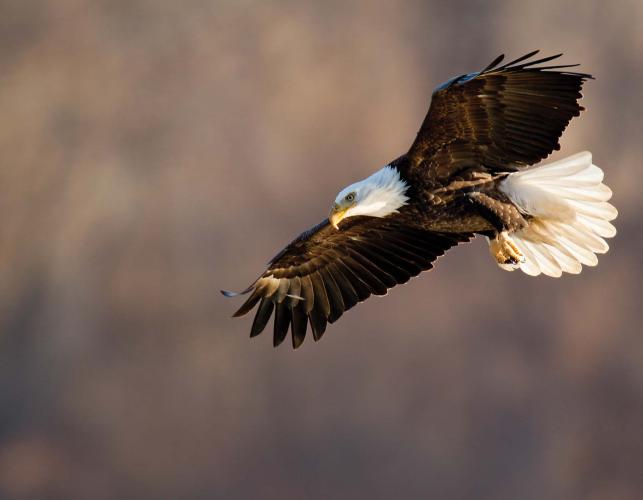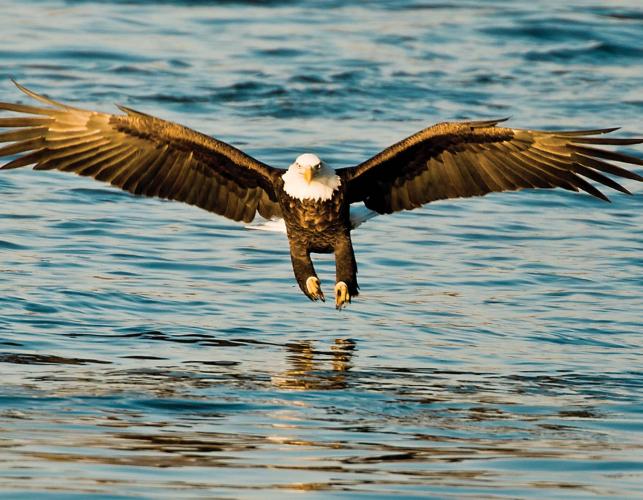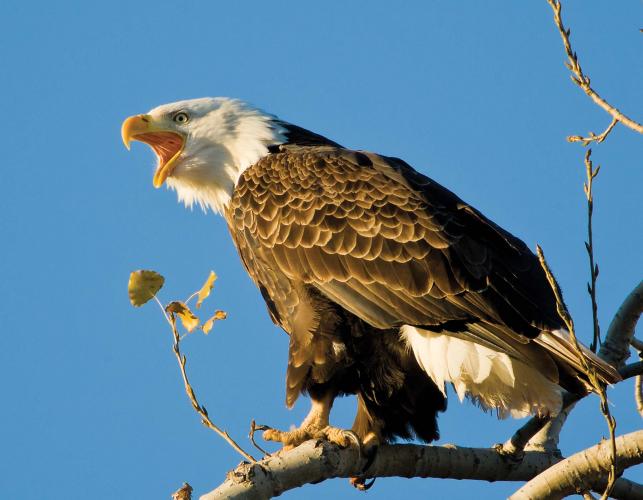The bald eagle, chosen as a national symbol in 1782, has long been admired for its grace, strength and power. Today, birders and photographers are still drawn to these impressive birds. Those willing to brave a frigid morning at Lock & Dam No. 24 on the Mississippi River in Clarksville may be rewarded with hundreds of bald eagles performing a spectacular, acrobatic air show and diving for fish. While the successful restoration of bald eagles makes it possible to see eagles year-round throughout Missouri, witnessing the high concentration along the Mississippi during the winter months is a dramatic experience.
In January, when the temperature drops to single digits and the river begins to freeze up, Lock & Dam No. 24 is the place to be. Here the Mississippi River runs through a hydropower plant and creates an open, ice-free area, which makes it easier for eagles to dine on floating and disoriented fish.
At sunrise, bald eagles leave their night roosting area to search for their favorite food, gizzard shad. With eyesight 5 to 6 times better than a human, eagles can spot fish from afar. An eagle dives to catch fish and then carries them off to eat. On a cold, clear day, there may be as many as 700 eagles (January 2009 bird count) on the river.
Not long ago, these symbolic birds were on the verge of extinction. In 1963, only about 500 nesting pairs of bald eagles were reported in the lower 48 states. Habitat loss, shooting, lead poisoning and pesticides contributed to the birds’ near demise. In 1978, bald eagles were declared an endangered species by the federal government in 43 states, including Missouri. It gave the birds the protection they needed and populations slowly began to bounce back.
Today, the birds have recovered, with more than 10,000 nesting pairs in the lower 48 states and more than 200 nesting pairs in Missouri. In winter months, when most lakes and rivers up north are ice covered, 2,000–3,000 bald eagles fly south to the ice free zones in Missouri where they can forage for fish and carrion.
The name bald eagle comes from the whiteness of the eagle’s head. The scientific name, Haliaeetus leucocephalus, means white-headed sea eagle. Their head and tail feathers begin to turn white at the age of 3, and they become mature at the age of 5. On average, females weigh about 15 pounds; males weigh about 10 pounds. Their wingspan can reach up to 8 feet. Eagles may live up to 30 years in the wild and 50 years in captivity.
There are several eagle hot spots in Missouri, areas that have 50–250 eagles each winter, including Lake of the Ozarks, Table Rock Lake, the Mississippi and Missouri rivers, Squaw Creek National Wildlife Refuge, Eagle Bluffs Conservation Area, Mingo National Wildlife Refuge, Lock & Dam 24 in Clarksville, Lock & Dam 25 in Winfield and Riverlands Migratory Bird Sanctuary Area near West Alton, Mo. Visit one of these areas this winter for an amazing show.










And More...
This Issue's Staff
Managing Editor - Nichole LeClair Terrill
Art Director - Cliff White
Staff Writer - Bonnie Chasteen
Staff Writer - Jim Low
Photographer - Noppadol Paothong
Photographer - David Stonner
Designer - Stephanie Thurber
Artist - Mark Raithel
Circulation - Laura Scheuler






















